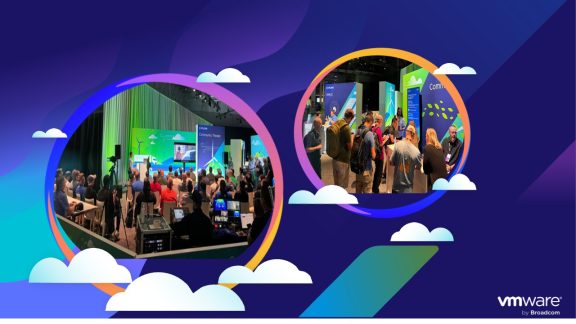VMworld Europe 2008 kicked off today with sessions for VMware partners. You can keep up with all the VMworld news here — we’re pretty much going to be all-VMworld this week. Or check out just the posts in the VMworld Europe 2008 category. I’ve also set up a special VMworld RSS feed for that category if you are a feed-reading type.
On Tuesday and Wednesday you’ll be able to view the keynotes via a recorded web cast by
3:00 p.m. Central European Time and 9:00 a.m. Eastern Standard Time
each day. A replay will be available for approximately one month.
[Skip this next paragraph if you aren’t interesting in Web 2.0 geekery.]
There are all sorts of bloggers on the ground in Cannes, and I’m watching various statuses update as folks land and get settled. You can watch along at Google Blogsearch, technorati, Twitter, Flickr, and YouTube. Since we’re all about pushing the envelope, VMworld attendee Lode Vermeiren’s Twitter micro-blogging posts are being aggregated over at Planet V12n under the user vmworld. Anybody at the conference, feel free to let me know @jtroyer and I’ll start following your tweets as well. I speak bad German and high school French, so be kind to me and give me tips in English. Technical note: since nobody can seem to decide on a single tag to use — VMworld, VMworldEurope, VMworld 2008 Cannes, etc., I’m just watching the firehose for VMworld and using old-fashioned human power to sort out the good stuff.
[OK, safe again for the virtualization geeks.]
Mikael Ricknäs at InfoWorld gives a nice wrap-up of today’s announcements. Link: Management tools take center stage at VMworld
Stage
Manager takes care of administrative duties, including testing and
integration, until a system is put into production. "You can test a new
service pack before it’s put into production," said Robin Prudholm,
senior systems engineer at VMware.Then, Lifecycle Manager takes over and is used until it’s time for the system to be retired, with the goal of combating "virtual
machine sprawl.""It’s really easy to create a new virtual machine and that sometimes leads to a loss of control, especially when you have
your IT department in more than one location," Prudholm said.With Lifecycle Manager, the creation of virtual machines is more tightly controlled.
"Whenever
an administrator needs to create a new virtual machine, he heads to a
portal and fills out which project the virtual machine is for and how
long it’s needed. A top-level administrator then approves the creation
of the machine. This puts the IT department back in the driver’s seat,"
Prudholm said.With the last tool, Site Recovery Manager, VMware wants to simplify the recovery of failed systems.
"Site Recovery Manager opens a lot of doors for small and medium-sized companies," Prudholm said.
Manlio Frizzi at Virtual Aleph is the first blog out of the gate with a post on a session about the newly-announced VMware Lifecycle Manager. Link: Technical Track – Vmware Lifecycle Manager
Michael Adams and Brian Emerson introduced us to the automatization, management and control of the life of a virtual machine.
The
VLM track VMs and report us on various states of VMs get during their
existence. With Lifecycle manager you can define policy for creation,
deployment, changes and retirement of VMs.Brian show us
a demo of the web access based interface in which a requester can asks
for a VM filling out requirement (OS, type of environment, ACLs,
domain,…) and the approver can trigger the creation of the requested
VM.
And clocking in at 11 minutes for the hardcore Fusionistas, here’s a video taking VMware Fusion for a spin from the show today.




